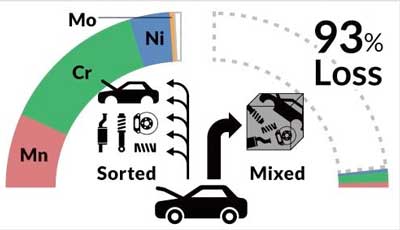| Jan 24, 2018 |
Optimizing recycling of scrap car parts yields big savings
|
|
(Nanowerk News) Sorting scrap car parts into just eight classes could increase recycling rates of alloy elements to over 97% in Japan, according to a study by Tohoku University researchers and their colleagues. Their analysis found that optimizing recycling could save Japanese steelmakers 31.6 billion yen ($287 million USD) on raw materials, and cut greenhouse gas emissions associated with obtaining new material by more than 28 percent.
|
|
While Japan mandates automobile recycling, scrap car parts are usually lumped together for iron, according to the study published in the journal Environmental Science & Technology ("Optimal Recycling of Steel Scrap and Alloying Elements: Input-Output based Linear Programming Method with Its Application to End-of-Life Vehicles in Japan"). This means specific alloy elements present in the scrap, such as manganese, chromium, nickel, and molybdenum, are not optimally recycled.
|
 |
| This is a schematic comparison between sorted and non-sorted scrap car parts recycling in terms of alloy elements recovery. (Image: Hajime Ohno)
|
|
The researchers analyzed the composition of scrap car parts and what they could be reused for, and found they are best suited for nine steel alloys. The analysis found that between 94 and 99 percent of the alloy elements could be recycled from the scrap car parts. The scrap metal would be melted down in electric arc furnaces and remade into steel products, such as coils, plates and bars. The recycled alloy elements could replace about 10 percent of the new material used by electric arc furnace (EAF) steelmakers.
|
|
While it sounds like a small portion of the raw material, that translates to huge savings -- steelmakers would save up to 15.2 percent spent on alloys. It would also reduce greenhouse gas emissions associated with the new material by 28.3 percent.
|
|
As part of their analysis, the researchers compared the tradeoffs between reducing costs versus emissions. They found that a small compromise on price could yield almost the greatest emission reduction. They were even able to identify which recycled alloy elements contributed the most to this equation, for the maximum benefit.
|
|
The authors note that their methodology can be applied globally and to other industries, helping find the optimal balance between costs and emissions to make the most of recycling efforts. This methodology will also help advance efforts to establish a circular economy, one that addresses products from cradle to grave and minimizes harmful environmental impacts.
|
|
Despite the potential savings, the authors anticipate that improving car scrap recycling systems will likely require policymakers to support development of new automatic sorting technologies for recyclers, as well as incentivize steelmakers to purchase sorted scrap at fair prices.
|

